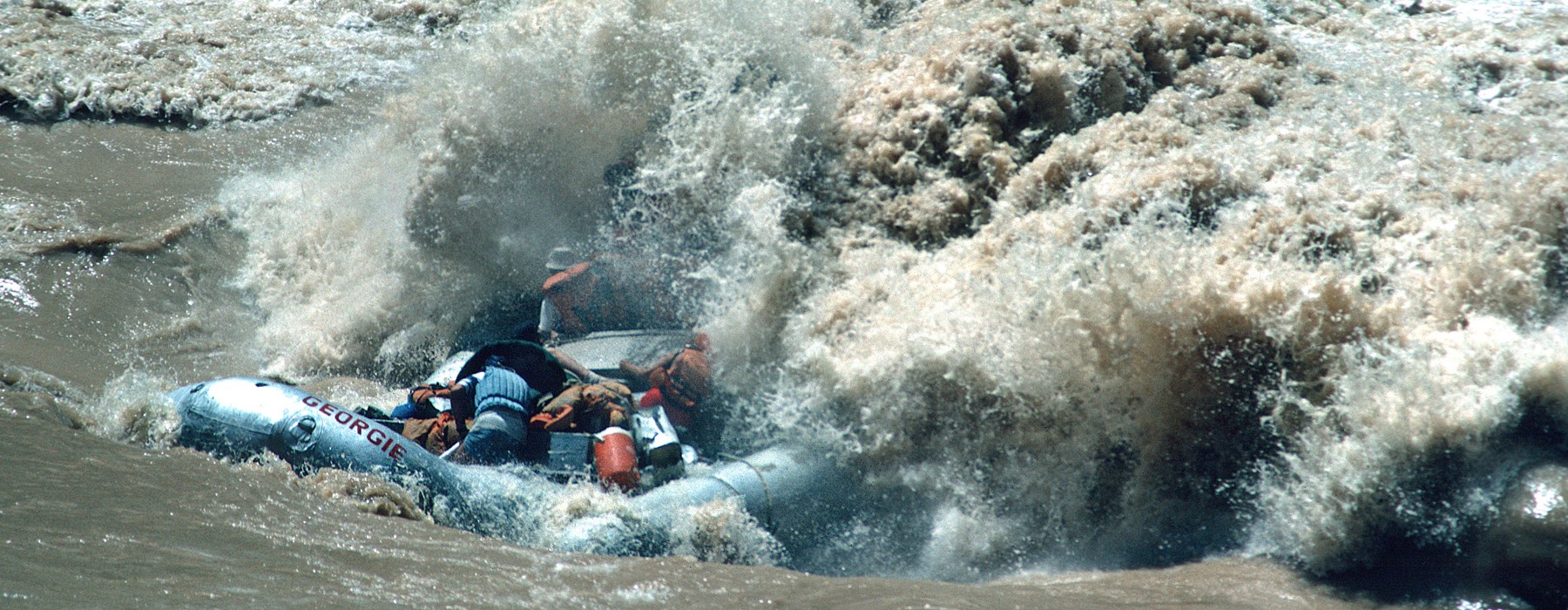
Georgie White: Grand Canyon Rafting Pioneer
The crew at Rivers & Oceans wants to celebrate and highlight the one and only Georgie White, a true Grand Canyon river legend. Georgie may be the most influential person in modern Grand Canyon whitewater history. She made a huge impact on the culture and river community, and initiated the modern motorized rafting industry. This post cannot do complete justice to her incredible character and accomplishments. However, it gives a brief history and tries to honor a wild woman of the water, Georgie White.
History
Born Bessie DeRoss in Oklahoma in 1911, she grew up in Denver, Colorado. By the age of 17 she had her daughter Sommona Rose, and went by her married name of Bessie Clark. At some point, she changed her name from Bessie to Georgia, which then became Georgie, perhaps after her father’s name, George. During and after the Great Depression, she moved around the country from Chicago to New York City. In this time she briefly married James White, her last namesake. After divorcing him, working odd jobs and trying to make ends meet, she moved back out west to southern California.
As time passed, this mother and daughter pair became extremely close. Georgie and Sommona began adventuring into the wilderness together, taking long trips to bike, rock climb, and hike. Tragically in 1944, a hit-and-run driver killed her 15 year-old daughter during one of their bike rides together. She changed after the incident, and many believe it led her to the desert, and eventually Grand Canyon.
Initial Grand Canyon Adventures
Georgie began hiking in Grand Canyon with her friend Harry Aleson, and they both took a liking to adventuring together. One day in late June of 1945, the two hiked down Diamond Creek road to the Lower Colorado River and “swam” 60 miles to Lake Mead in big lifejackets and flippers. The river raged at 125,000 cfs, 3 to 4 times the flow of what modern river runners see. Three days later with their gear still salvageable, they arrived exhausted, but intact. The rafting industry was just beginning to take off post World War II, and their wild adventure made for exciting press about the wonders of river travel. So began Georgie’s river career and love affair with the Colorado River and Grand Canyon.
Vintage Video about Georgie Clark and Her Motorized Grand Canyon Rafting Trips
Grand Canyon Rafting History
Georgie had become the first female to row the river from Marble Canyon to Lake Mead in 1952. During this time, the river running industry barely allowed women to join trips, let row their own rafts. She knocked down barriers and pushed her way into the top. Georgie began taking customers on trips, and created her own style latching three rafts together for more stability in whitewater. Although she didn’t known it at the time, this “triple rig” was the precursor to modern Grand Canyon motorized rafts.
Rafting Georgie’s Way
Although many other boaters at the time ran classic wooden dories and discounted rubber rafts, Georgie marched to her own drum and not bothered by what people thought of her motives and operations. Her company, called “Georgie’s Royal River Rats” operated for about 45 years. National press, including TV shows and newspapers gravitated towards her wild character and eclectic style. She was the first female to run her own commercial rafting company in Grand Canyon, and her impact on the boating community has lasted generations.
Often dressed in her classic river “uniform,” Georgie sported a bright red, Mae West style lifejacket, a leopard print leotard suit, and often had a Coors in one hand and a cigarette in the other, sitting back in her motor well with a big grin. Off duty firefighters from Los Angeles made up her crew, strong workhorses with first aid training.
Georgie sported a bright red, Mae West style lifejacket, a leopard print leotard suit, and often had a Coors in one hand and a cigarette in the other, sitting back in her motor well with a big grin on her face.
Motorized Rafting
Georgie White pioneered by being the first woman to outfit Grand Canyon rafting trips, and also how she did it. The motor rafting industry here owes a lot of its history to Georgie. Although not for everyone, motor trips in Grand Canyon have become the most popular way to see the river. Trips range from one to nine days, and for a lower price and less time than human powered crafts. Those trips were the precursor to the most most popular modern trip, a 7-day motorized full canyon rafting trip.
Crystal Rapid, 1983
Once Georgie began running commercial trips regularly, other outfitters often frowned upon her style of trip. Sometimes she didn’t take customer safety seriously and had two fatalities on her trips during the course of her career. The following story about running Crystal Rapid during the historic high-water flood year of 1983 is sourced from the book written by Kevin Fedarko called, “The Emerald Mile: The Epic Story of the Fastest Ride in History Through the Heart of the Grand Canyon.”
“White had no intention of modifying anything as she bore down on Crystal at the helm of her mammoth boat on the morning of June 23, 1983 and set herself up for a maneuver that Brian and his squad of river rangers could see was patently insane. As the rangers watched, stupified, White shut off her motor, levered the propeller out of the water, and allowed the current to carry her across the top of the rapid, a gambit known as dead-sticking.
Without power, steerage, or any other form of control, the Queen Mary now boasted all the agility and responsiveness of a dead manatee. While her passengers who had no idea what was about to occur- threw their arms into the air and screamed in excitement, White crouched in the bottom of her motor well and braced her feet against the rubber. Then the boat was seized by the accelerating current and hurled into the hole.
By dint of it’s prodigious mass, the Queen Mary was too large even for Crystal to flip upside-down. Instead the boat danced indecisively inside the hole, first fainting downstream, then retreating upstream. In this violent game of cat and mouse, the pontoons were wrenched side to side, pulsating like the bellows of an accordion as the current probed for a weak point. In light of this punishment, the boat was fairing remarkably well. Unfortunately, White’s cargo and passengers were not so successful. Each time the raft buckled and sprang back, the rangers could see bodies and pieces of gear being ejected.
“They don’t make passengers like they used to.”
Georgie White, after running Crystal Rapid at high-water in 1983.
To the astonishment of the rangers, all of White’s passengers had survived. After gathering everybody up, Brian walked down along the shoreline to check on White, who was now standing in the motor well holding a can of Coors and surveying the damage. Every item of gear and equipment on the Queen Mary had been stripped from the boat. Brian saw nothing left on board except for the motor, which was still strapped to the mount, and, remarkably, White herself. “Georgie, what happened?” asked Brian. She looked at him and winked. “I told ’em to hang on.” She shrugged. “They don’t make passengers the way they used to.”
Lasting Legacy
Georgie died of cancer in 1992 at the age of 81, after her last Grand Canyon river trip in 1991. Although many in the river community fought to have a larger rapid renamed in her honor, a 3-2 vote from the U.S. Board on Geographic Names allowed for Twenty-four rapid to be named “Georgie’s Rapid.” Just like her, this sassy rapid keeps you on your toes and can kick you in the pants.
Georgie White left a legacy on Grand Canyon’s boating community not only as one of the original “characters,” but also her rafting innovations. The majority of travelers make their way commercially down the river each year by motorized raft. Her triple rig has been redesigned multiple times in recent decades, but is based on her creative invention. Although folks may say what they wish about her often lackadaisical approach to running river trips and whitewater, Georgie influenced our industry beyond measure. Perhaps we can all appreciate a spearheading woman who broke down gender barriers in a world that was mostly inaccessible to women working on the Colorado River in the Grand Canyon.
Read about Katie Lee another pioneering river runner. Or learn about Grand Canyon rafting trips.




